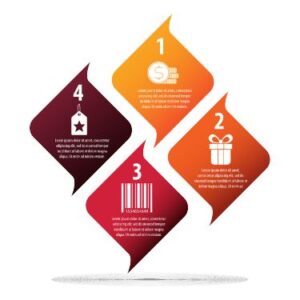Things to be considered while representing data
- Purpose: The purpose of the data representation should be clear. It is essential to understand why the data is being presented and what insights can be drawn from it. This step is crucial and considered the most useful tip for data presentation.
- Audience: The data presentation should be designed for the intended audience. It is important to know who will be viewing the data and tailor the presentation accordingly.
- Accuracy: The data should be accurate and reliable. Any errors or inconsistencies in the data can lead to incorrect conclusions.
- Context: The data should be presented in the appropriate context. This includes the time period, location, and other relevant factors that can impact the interpretation of the data.
- Format: The format of the data presented should be appropriate for the type of data being represented. For example, charts and graphs may be more suitable for numerical data, while tables may be more appropriate for text-based data.
- Clarity: The data should be presented in a clear and concise manner. The presentation should be easy to understand and not cluttered with unnecessary information.
- Visual appeal: The data presentation should be visually appealing. The use of color, font, and layout can enhance the presentation and make it more engaging.
- Interpretation: The data should be interpreted accurately. This involves analyzing the data and drawing conclusions that are supported by the evidence.
- Conclusion: The data presentation should lead to a clear conclusion. The audience should be able to understand what the data means and what actions can be taken based on the information presented
How to attract audience from your presentation?
- Start with a hook: Start your presentation with a question, interesting fact, or relevant anecdote that captures the audience’s attention and sets the tone for the rest of the presentation.
- Use visuals: Incorporate charts, graphs, images, and other visual aids to make your data more engaging and easier to understand. This also breaks up the monotony of text-heavy slides.
- Use storytelling: Present your data in the context of a story, making it easier for the audience to relate to and understand.
- Use concise language: Avoid using jargon or technical language that might confuse or bore your audience. Use simple language and get straight to the point.
- Use humour: Use appropriate humour to keep the audience engaged and interested.
- Interact with the audience: Ask questions, allow for questions, and encourage feedback. This makes the presentation more interactive and helps keep the audience engaged.
- Use your body language: Use gestures and make eye contact to engage the audience and hold their attention.
- Practice your delivery: Practice your presentation to ensure a smooth delivery and to eliminate any unnecessary filler words or pauses.
- Highlight key takeaways: Summarize the key points and takeaways at the end of the presentation to reinforce the most important information.
- End with a call to action: Encourage the audience to take action based on the information presented. This could be anything from changing behaviour to signing up for a service.
Do's and Don't s while Representing the Data
Do’s
- Clearly define the objective of the data representation.
- Choose appropriate charts or graphs to represent the data.
- Ensure the accuracy and relevance of the data.
- Use clear and concise labels and titles for the charts or graphs.
- Highlight the key findings and trends in the data.
- Provide context and explain any anomalies or outliers.
- Use a consistent color scheme and formatting throughout the representation.
Don’ts
- Misrepresent or manipulate the data to support a predetermined conclusion.
- Use overly complicated charts or graphs that are difficult to understand.
- Use inappropriate or unclear labels and titles for the charts or graphs.
- Overload the representation with too much information or data points.
- Leave out important context or explanations for the data.
- Use too many colours or formatting that distract from the data.
- Use jargon or technical terms that may not be understood by the audience.







